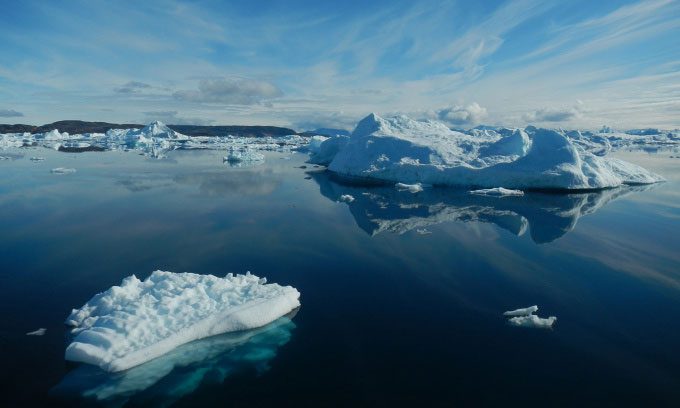About 117 million years ago, sea levels were approximately 210 meters higher than today, but this may not have been the highest level in history.
Rising sea levels due to climate change are causing glaciers and ice sheets to melt rapidly, leading to increased water levels in the oceans amid a warming world. So, have sea levels ever been higher than today, and when was the peak? According to scientists, sea levels in the past were much higher than today, but it is unclear exactly when the highest point was reached.
If we consider the last half billion years, sea levels likely peaked around 117 million years ago during the Aptian period of the Cretaceous. A study published in the journal Gondwana Research in 2022 indicates that during this time, sea levels were about 210 meters higher than today.

Icebergs off the southwestern coast of Greenland. (Photo: NASA/JPL-Caltech).
“Over the past 540 million years, the highest sea levels occurred during the Cretaceous period, when dinosaurs roamed the Earth,” said geologist Douwe Van der Meer at Utrecht University, the lead author of the study.
“For more distant periods, it is essentially speculation,” said Jun Korenaga, a professor of planetary and Earth sciences at Yale University. According to a study conducted by Korenaga, sea levels were higher during the early history of Earth, which is about 4.5 billion years old, when the first continents were forming and the Earth’s surface was nearly devoid of dry land.
In the short term, sea levels are closely linked to the melting of ice. For example, if the Thwaites Glacier in Antarctica melts, the entire West Antarctic Ice Sheet could collapse, causing global average sea levels to rise by about 3.4 meters. In the long term, the movement of tectonic plates and the expansion of the ocean floor also affect sea levels. Additionally, Korenaga believes that the early oceans contained more water than they do today. Since Earth formed, oceans may have gradually seeped into the planet’s mantle.
The last time sea levels were higher than current levels was about 120,000 years ago, during the Last Glacial Maximum. During this period, a warmer climate caused ice to melt in Antarctica, resulting in peak sea levels that were about 6 meters higher than today’s average.
When Earth is completely or nearly ice-free, sea levels could be ten times higher than during the Last Glacial Maximum. “If we go back about 50 million years, when there was no ice in Greenland and Antarctica, sea levels would be around 70 meters higher,” Van der Meer stated.
The highest sea levels occur when there is the least ice, but this does not fully explain the high sea levels during the Cretaceous period, when 30% of today’s dry land was submerged. Tectonic plate movements are also a contributing factor.
Van der Meer estimates that the highest sea levels occurred around the time when the South American plate drifted away from Africa, about 200 million to 100 million years ago. These plates were pushed apart as the South Atlantic Ocean formed in between. According to Van der Meer, new oceans tend to be shallower than the oceans they replace. During the Cretaceous, the combination of a lack of polar ice and shallow oceans led to the highest sea levels in about half a billion years.
Looking further back beyond half a billion years, during periods with fewer geological evidence and scientific data, sea levels could also have been very high. In a study published in the journal Philosophical Transactions of the Royal Society A, Korenaga and colleagues estimated that the Earth’s surface originally contained twice the amount of water present today.
Like tectonic plates, water can circulate in and out of the magma layer beneath the Earth’s crust. Korenaga’s calculations indicate that a portion of the ocean water on the Earth’s surface has been lost over billions of years. If this calculation is accurate, then even if sea levels continue to rise today, the peak may already be in the past. The early seas on Earth had higher levels simply because there was more water at that time.



















































